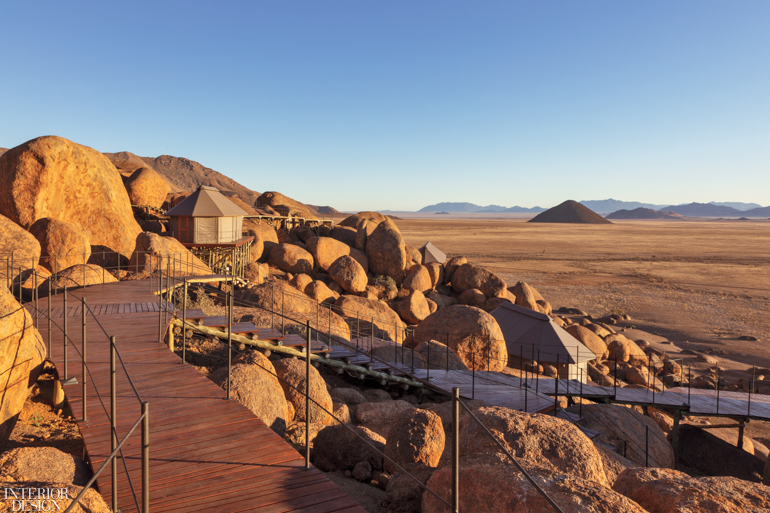Luxury Encampment Zannier Hotels Sonop Casts a Hypnotic Spell in Namibia

From the land of barking geckos and bespoke Land Cruisers, ancient deserts and private airstrips, greetings! Zannier Hotels Sonop, an exclusive luxury encampment in the Republic of Namibia, in southwestern Africa, is the latest edge-of-the-map hospitality project from the boutique group based in Ghent, Belgium.
Sonop, which means sunrise in Afrikaans, comprises 10 meticulously outfitted residential tents and ancillary canvas structures. Built on stilts, they sit among an outcropping of boulders at the edge of the Namib, widely considered the oldest desert in the world. Almost no one lives there. Angelina Jolie tipped off founder and CEO Arnaud Zannier to the place. From the cigar lounge at Sonop, it’s like looking at the world before we got here.

“Would it be, infinity?” asks Geraldine Dohogne, Zannier’s group director of interior design, trying to describe the experience of staying at Sonop. “You have landscapes that don’t end,” she continues, a phenomenon the designer complements by supplying the kind of textures and details “you need to feel at home, that give a sense of place.” Quentin Guiraud, Zannier’s head of communications, shares his first impression: “You feel like you’re on Mars.” But that’s before you get to the spa.

It’s hard to compete with Africa for “sense of place”—without any hotelier’s help, it’s a diamond as big as the Ritz—but Sonop gives it a good shot. In addition to a desert-side heated infinity pool and bar that’s also an outdoor cinema (The Lion King among its repertoire—need you ask?), there are wellness treatment rooms, a fitness center, stables, and a gastronomically ambitious restaurant with black-tie service (jackets and dresses recommended). Off-site, there are hot-air balloon safaris, electric fat-bike trails, and dune-top breakfasts and Champagne dinners with starched linen tablecloths and a personal chef.

Dohogne’s task was a tough one. How to put “there” there, where there isn’t any “there”—and that’s the point. How to install highly amenable lodging for guests without disturbing what they’ve come to enjoy: the vast nothingness, populated only by stars, skies, and the hypnotic reverberations of emptiness.

On the exterior, Sonop is effectively invisible. The guest tents, which have solid wood frames and sit on sturdy acacia-stilt platforms, are large: from 400 to 800 square feet. But set at different levels among the massive boulders, the earth-color canvas cabins dissolve into the outcrop. Larger communal tents for reception, lounges, restaurant, and the like are perched along the crest of the formation, while at its base, the spa is housed in a traditional compacted-sand structure coated in pigmented mud the same rusty-gold as the surrounding desert. Boardwalks meander through the rocks, not only connecting the various parts of the property but also providing continually reoriented vistas or winding up at discreet destinations like the pool, which seems to appear as magically as an oasis where the boulders meet the sand—strategies that open up the 1 1/3-acre encampment and dispel any sense of tight quarters. As Dohogne says, “Every moment is a different view, even if you’re looking at the same area.”

Largely drab on the outside, Sonop has a rich interior life, which is a conscious contrast. Dohogne took her cues from what she feels is the most superb historical example of roughing it in style: British colonial expeditions of the 1920’s. “While ‘under canvas,’ as life in camp was called, an officer and a gentleman assured himself a high degree of comfort,” Nicholas A. Brawer writes in British Campaign Furniture. The designer followed suit, adding a touch of Aladdin’s cave to the aesthetic.

Dohogne furnished the camp with antiques and vintage pieces, including mahogany chairs, leather trunks, and nicely worn, wine-red rugs—many hand-picked at flea markets and dealers in England—mixed with locally sourced fabrics and art. There are deep claw-foot tubs in the bathrooms, for a proper end-of-day soak; craft notepaper and pen on the desks, for keeping a travel diary; and floor-standing telescopes in the tents, for celestial navigation: part function, part romantic fantasy. “I’ve never seen the Milky Way like that,” Guiraud reports with awe. “Or the Moon so close.”

Dohogne also had to contend with issues unique to the location. Aside from having to construct the compound on a 100-foot-tall heap of boulders—sure-footed local crews took care of that—trade-offs on energy consumption had to be made, since Sonop uses nothing but solar power. Mini-bars, for example, are actual iceboxes, which fits into the thematic conceit nicely. To help lessen reliance on air conditioning and heating (temperatures can reach up to 100 degrees during the day and drop to freezing at night), tents have double-layer roofs. Canvas walls, which roll up for maximum exposure to terraces and the landscape beyond, roll down for climate control.

All mechanical systems had to be dead quiet: The silence in the desert is as intense as its visual impact, and one of its most crystalline qualities. Barking geckos, yes; throbbing generators, no. Communal buildings are arranged in a U-shape, to shelter the decks from strong winds that come up periodically.

And then there’s the light, or the remarkable absence of it. “We didn’t want to make a big sparkle in the desert,” says Dohogne (the stars have that covered), so there are no statement light fixtures. Minimum electric sources—pin-spots in public spaces, soft and sparse incandescents in the guest tents—and pleasing candlelight in the lounges and restaurant, make Sonop glimmer like a distant galaxy, not glare like a Land Cruiser’s headlamps.
“I remember one day going out onto the platforms, before the tents went up,” the designer recalls, “and thinking, This is the feeling of being on top of the world.” And in the evening, as the curtain of night descends and parts, being beneath the universe.





Project Team: Sign: Graphics Consultant. Pepe Bush Camp Builders: Woodwork. Emcon Consulting Group: General Contractor.
> See more from the October 2019 issue of Interior Design


